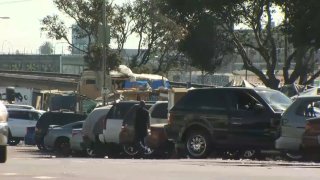
City officials in Oakland approved a contentious new policy that will prohibit homeless people from setting up tents in parks or near homes, businesses, schools and some churches in the city that has seen a recent spike in the homeless population.
The Oakland City Council unanimously approved the measure Tuesday after more than 100 community members spoke mostly against the rules that also allow homeless encampments in certain areas of the city as long as they follow safety and sanitation rules.
Mayor Libby Schaaf said the policy, which will start being enforced in January, establishes Oakland’s first citywide rules on homeless encampments. She called it “a compassionate response to an unacceptable condition.”
“I’m grateful to the City Council who voted unanimously for a new encampment policy that will help us improve the well-being of all our residents, housed and unhoused,” she said in a statement. “Ending homelessness is a moral imperative.”
The homeless population has jumped by 63% since 2017 in Oakland, where the median house sales price is about $750,000. There are about 4,000 homeless people — many of them living in at least 140 encampments of tents and RVs.
“The problem has outgrown the City’s current policy environment,” Joe DeVries, director of Interdepartmental Operations, said in a report.
Under the new rules, homeless people won’t be allowed to set up camp within 150 feet of a middle school, preschool or child care center, or within 100 feet of high schools, or within 50 feet from homes, businesses, public parks and places of worship, or within 25 feet of a homeless shelter.
Homeless encampments can be in a “high-sensitivity” area as long as they are managed by non-profit or faith-based organizations, according to the new rules. The city defines such areas as places where an encampment can impact the health and safety of both homeless and housed populations.
They will be allowed to set up tents in “low-sensitivity” areas. But they will be limited to one side of the street, and won’t be allowed to block sidewalks or bike lanes, store flammable materials or tires or take up more than a 12-by-12-foot area per person.
Camps in the permitted areas that break the rules and are set for closure will be given a 72-hour notice and residents will be offered temporary shelter. No one will be cited or arrested for camping in public spaces.
“This isn’t to criminalize folks. This is to say if you’re going to live here, let’s establish some basic standards to protect your own safety,” Homelessness Administrator Daryel Dunston said during the virtual council meeting, the East Bay Times reported.
Critics of the rules said it will push the homeless population away from the city and into desolate industrial areas near the Oakland Airport and the Oakland Port where they will be cut off from public transportation and will be far away from the few resources they can access.
“What this policy tries to do is actually make the homeless population invisible to give a cosmetic effect that homelessness has been solved,” said Needa Bee, a homeless mother of two who was evicted from her home in Oakland two years ago and lives with her children in a camper.
Bee is the founder of a grassroots collective called The Village, which administers roughly 40 Oakland homeless encampments. She said the policy is an effort by city officials to prepare for a wave of homelessness the city will see when the federal eviction moratorium ends by January 1.
“There is going to be a massive wave of evictions happening and when they do, these people will be made invisible instantly because they will be out of sight and out of mind of the housed population,” Bee said.
Dunston said during Tuesday’s meeting that the city will work to double its outreach capacity and launch a second public works crew dedicated to clean trash from the encampments. The city also will establish a database to track the status of each encampment, and develop a mobile app that outreach workers can use to report on camp conditions in real-time.
Oakland City Council members also added amendments to the policy to require city staff to identify land in all seven districts for sanctioned encampments, something Bee said was promised by the city three years ago.
The new rules come as unsheltered communities mushroom throughout the San Francisco Bay Area with clusters of homeless people setting up tents along busy sidewalks, parks, under overpasses and in vacant lots.
In San Francisco, city officials launched emergency safe sleeping sites to respond to a ballooning homeless population, fencing off sites in public plazas or parking lots to allow homeless people to set up socially distant tents.
The sites, however, are intended only as a temporary solution during the pandemic.

